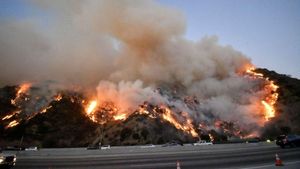The investigation surrounding the mid-air collision between an American Airlines flight and a US Army Black Hawk helicopter over the Potomac River has uncovered concerning staffing issues at Reagan National Airport.
On January 31, 2025, at around 9 PM local time, tragedy struck as both aircraft collided, resulting in the deaths of all 67 individuals on board. Affectionately known as DCA, Reagan National Airport has become the center of attention as officials seek to determine the causes behind this catastrophic incident.
Early reports indicate the incident was exacerbated by abnormal staffing at the airport's air traffic control tower. Regulatory body, the Federal Aviation Administration (FAA), noted in their preliminary findings, "one controller should be in charge of helicopters, and another watches over airplanes... Staffing levels were 'not normal' for the time of day and volume of traffic." The usual protocol was apparently not followed, with responsibilities for managing both helicopters and airplane traffic falling to just one air traffic controller.
Eyewitness accounts from radio transmissions the night of the crash revealed the lone controller expressed concerns to the AWAX crew about their proximity to another plane. Despite this warning, it remains unclear whether the helicopter pilot received accurate information about the American Airlines flight's location until it was too late. Reports suggest the helicopter was flying at altitudes exceeding the approved maximum of 200 feet.
The responsibility of managing air traffic—divided between helicopters and airplanes—was reportedly combined before 9:30 PM on the night of the collision, according to sources briefed on internal FAA discussions. Prior to this time, such duties are typically not merged, and usually, two controllers are assigned to handle traffic until the airspace starts to clear out. The decision to operate with only one controller raises significant questions about staffing protocols at the National Aviation System.
Over the years, the air traffic control tower at Reagan has faced chronic staffing shortages. Presently, only 19 certified controllers are reported to be available, with the FAA mandatorily recommending staffing levels of 30 qualified personnel. This continued understaffing has caused controllers to work extended shifts, often 10 hours long across six days, leaving them under immense pressure.
James Hall, the former head of the National Transportation Safety Board, emphasized the importance of these staffing levels for public safety. "The American people enjoy the safest aviation system in the world. I don’t doubt there should be changes, but we must not forget lives are at stake." These remarks echo long-standing concerns from air safety professionals who have reiterated the necessity of adequate staffing to prevent future tragedies.
President Donald Trump weighed in on the aftermath of the crash, criticizing air traffic control efficiency. Speaking on Truth Social, he stated, "Competence would be, you’re not gonna have a shortage, but if you had the right people, you wouldn’t need as many people either." Such statements have ignited debates about the efficacy of air traffic control operations and broader government reforms.
Trump also highlighted his disappointment over how the incident unraveled, particularly emphasizing the helicopter's altitude. He stated, "The Black Hawk helicopter was flying too high, by a lot. It was far above the 200ft limit. That’s not really too complicated to understand, is it???” His rhetoric suggests he believes systemic issues within federal agencies may have contributed to the tragedy.
The National Transportation Safety Board has taken the lead on investigating the collision, with investigators analyzing data from the recovered black box. They are also examining factors surrounding helicopter operations during the collision, including whether the Army Black Hawk was breaching prescribed altitude limits when it collided with the passenger jet.
This horrible ceremony of negligence is not the first of its kind nor will it be the last without progressive change. Critics of federal hiring practices and budget cuts have long warned of the dangers posed by such frames of thought, particularly within life-and-death sectors like aviation.
Determining the underlying causes of this collision is of utmost importance for the surviving families of those lost, as well as for public confidence in the air travel system. Addressing staffing shortages, reassessing protocols for air traffic management, and deploying more experienced controllers must be prioritized to prevent future disasters.



